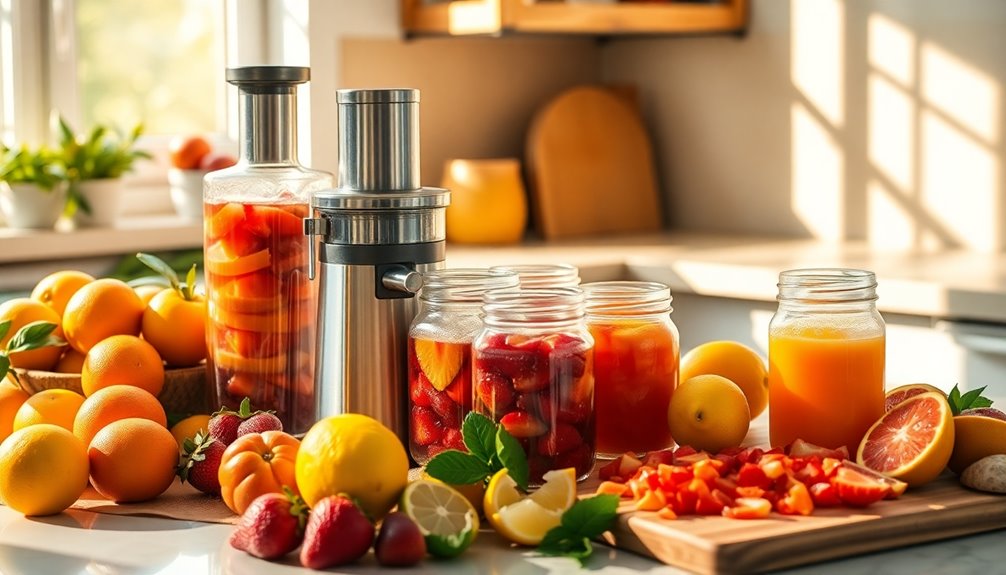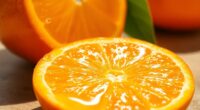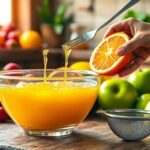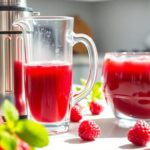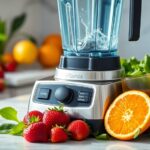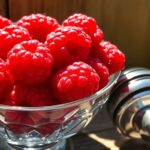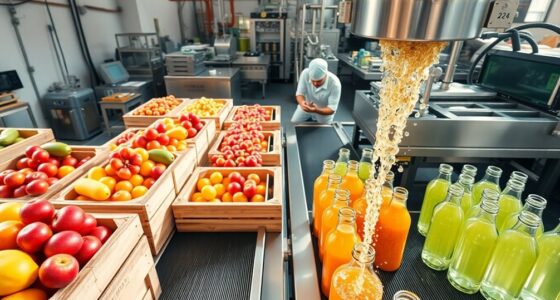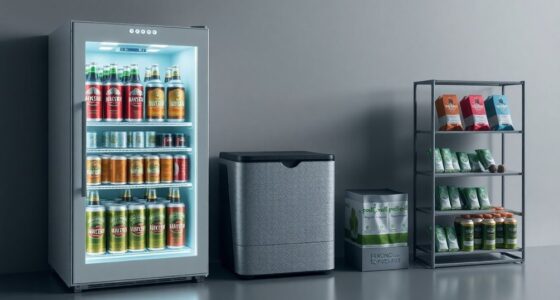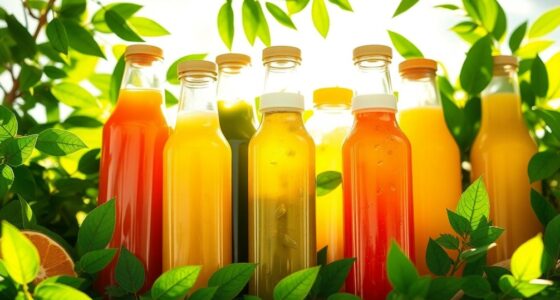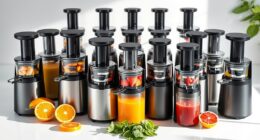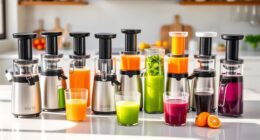If you're looking to make fresh fruit juice at home, you've got some great options! Try juicing with a blender—it's simple and only takes a few minutes. The classic stovetop method infuses flavors beautifully, while cold pressing preserves nutrients for a longer shelf life. You can also get creative by infusing your juices with herbs and spices, adding a unique twist. Stick around, and you'll find more on these fun methods!
Key Takeaways
- Blender Method: Chop fruits, blend with water for 2-3 minutes, strain for smooth juice, and store in the fridge for 1-2 days.
- Stovetop Method: Simmer seasonal fruits in water, add sugar, strain, and serve chilled; leftovers last up to a week in the fridge.
- Cold Pressing: Use a masticating juicer for nutrient-rich juice, yielding more and lasting up to 72 hours without significant oxidation.
- Herb and Spice Infusion: Enhance juice flavors using herbs like mint or spices like ginger, adding health benefits without extra sugars.
- Tailored Juices: Customize juice recipes to suit personal taste preferences, maximizing both nutrient intake and enjoyment.
Juicing With a Blender: a Simple Approach
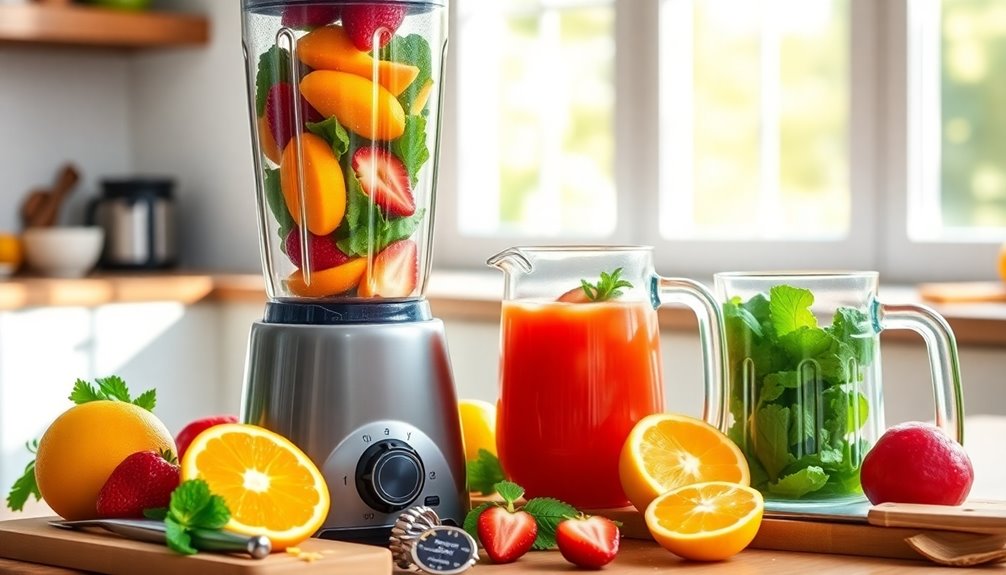
If you’re looking for an easy way to make fresh fruit juice at home, using a blender is a great option. Not only is it quick and convenient, but you also have complete control over the ingredients and flavors. You can customize your juice by mixing different fruits, adding a splash of lemon for tanginess, or even including leafy greens for added nutrition. Explore various diy fresh fruit juice methods to discover your favorite combinations and enjoy a refreshing drink packed with vitamins.
Start by chopping your chosen fruit into smaller pieces. This helps you blend them into a smooth consistency.
Next, add about 1/4 to 1/2 cup of water to the fruit to ease blending and prevent thick mixtures.
Blend on high speed for 2-3 minutes until everything's well incorporated.
If you prefer a clearer juice, strain the mixture through a fine-mesh strainer or nut milk bag to remove pulp.
Also, consider adding fresh herbs like mint or basil to elevate the drink's freshness.
Store your freshly made juice in airtight containers in the refrigerator and make sure it's consumed within one to two days for the best flavor and freshness.
Enjoy your delicious creation!
Classic Stovetop Method for Homemade Juice
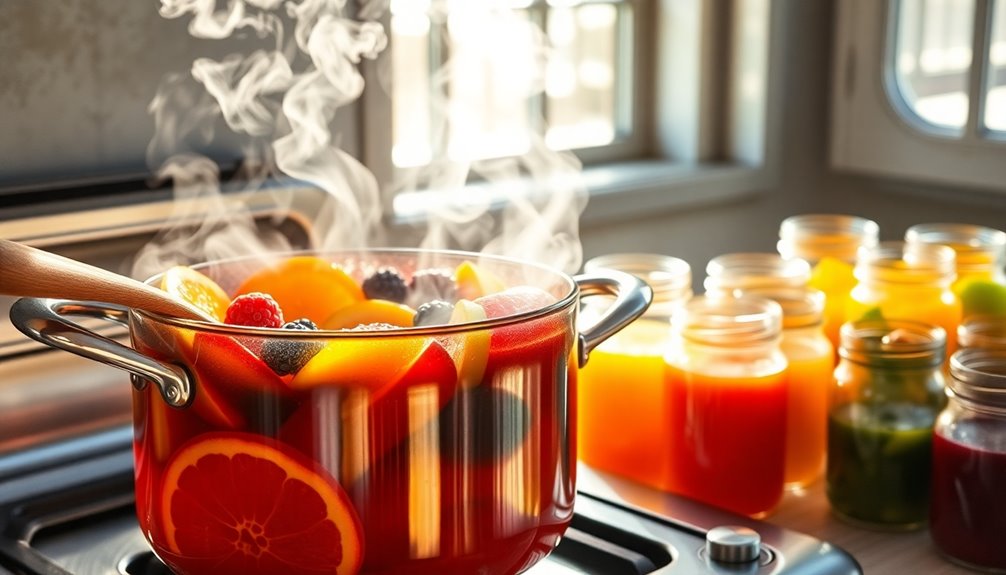
Using a blender is a convenient way to make fresh fruit juice, but the classic stovetop method offers a traditional approach that brings out rich flavors.
To create homemade juice, start by placing your chosen seasonal fruits in a large pot and adding enough water to cover them. Bring the mixture to a boil, then stir in sugar to taste and let it simmer for about 10-15 minutes. This process extracts the fruit's flavors beautifully.
Once it cools, strain the mixture through a fine mesh sieve or cheesecloth to separate the juice from the pulp. You can decide whether to discard the solids or leave some for texture.
Serve your invigorating beverages chilled and store leftovers in airtight containers for up to a week.
Cold Pressing: The Art of Extracting Juice

Cold pressing is an innovative technique that allows you to extract juice from fruits and vegetables while preserving their essential nutrients and flavors. Using a masticating juicer, you crush and squeeze ingredients, minimizing oxidation and nutrient loss. This method yields more juice and retains richer flavors, especially from leafy greens and delicate fruits.
| Benefits | Cold Pressing | Traditional Juicing |
|---|---|---|
| Nutrient Retention | High | Moderate |
| Juice Shelf Life | Up to 72 hours | Shorter |
| Flavor Intensity | Smoother extraction | Often diluted |
Infusing Flavor: Creating Juice With Herbs and Spices
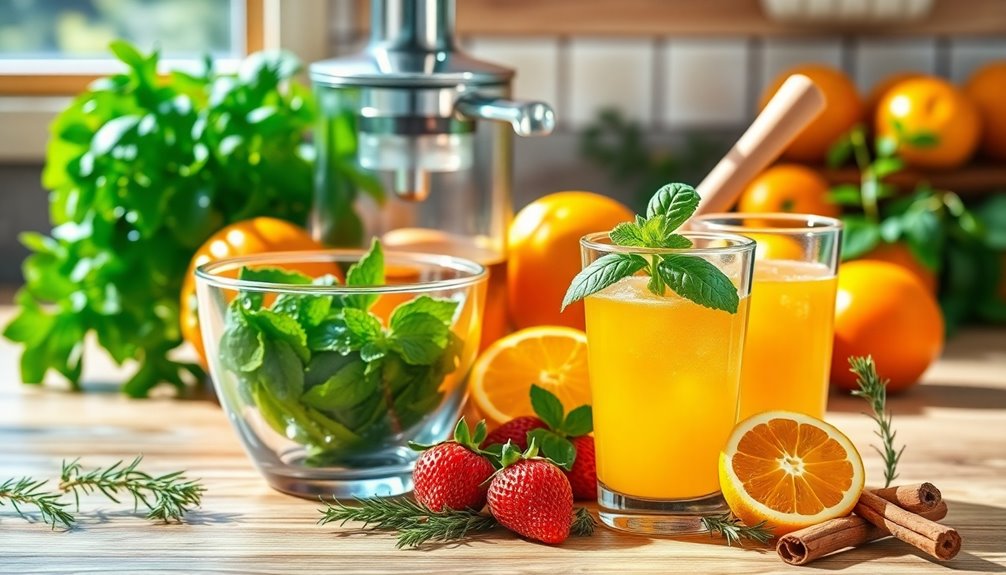
While many people enjoy the natural sweetness of fresh fruit juice, adding herbs and spices can elevate your drink to new heights. Infusing your juice with herbs like mint, basil, or cilantro enhances vitality and introduces unique flavor profiles.
Spice things up with ginger, turmeric, or cinnamon for warmth and complexity; ginger even offers anti-inflammatory benefits. Experiment with combinations, like pairing basil with watermelon juice for a revitalizing twist.
Not only do herbs and spices boost flavor, but they also increase the nutritional value of your juice, contributing vitamins and minerals without extra sugars. For instance, vitamin C from herbs like basil can complement the health benefits of the fruits in your juice.
To effectively infuse flavors, blend your chosen herbs and spices with fruits in a high-powered blender, then strain for a smoother texture if desired. Enjoy your flavorful creations!
Frequently Asked Questions
How to Make Fresh Juice at Home?
To make fresh juice at home, start by selecting ripe fruits and vegetables.
Fill a pot with enough fruit to cover about one-third of its volume, then add water. Bring it to a boil, stirring in sugar if you like.
Once boiled, let the mixture cool, then strain it through a fine-mesh sieve to separate the juice from the pulp.
Store your juice in airtight containers in the fridge and enjoy it fresh!
What Is the 80 20 Rule for Juicing?
You'll be amazed to discover the 80/20 rule for juicing!
Envision this: 80% of your juice bursting with vibrant veggies and leafy greens, while a mere 20% adds a splash of fruity sweetness.
This magical balance keeps your juice nutrient-dense and low in sugar, making it a superhero for your health.
What Are the Methods of Making Fruit Juice?
When you're looking to make fruit juice, you've got several methods at your disposal.
You can use a blender to mix fruits with water, then strain it for a smooth drink. A juicer extracts juice directly from whole fruits, while boiling chopped fruits in water creates a flavorful beverage.
If you've got frozen fruits, blending them with liquid gives a revitalizing treat. For citrus, a squeezer maximizes juice extraction and flavor.
Choose what suits you best!
How Long Can Fresh Juice Last in Mason Jars?
You'll be pleased to know that fresh juice can last up to three days in mason jars when stored in the fridge, but for the best taste and nutrients, drink it within 24 hours.
To keep your juice fresher longer, fill the jars to the brim and consider using dark-colored ones to block light.
Remember to store them in airtight containers to maintain that delicious flavor and nutritional value.
Enjoy your invigorating drink!
Conclusion
Now that you've explored these four delightful DIY methods for making fresh fruit juice at home, it's time to put your newfound knowledge to the test. While some believe that cold pressing preserves more nutrients than blending, studies show that both methods can yield nutritious results. So, experiment with each technique and discover what you love best. With a little creativity, you'll be sipping on delicious, homemade juice that's bursting with flavor and health benefits!
Cindy thoroughly researches juicing trends, techniques, and recipes to provide readers with practical advice and inspiration. Her writing style is accessible, engaging, and designed to make complex concepts easy to understand. Cindy’s dedication to promoting the advantages of juicing shines through her work, empowering readers to make positive changes in their lives through the simple act of juicing.

